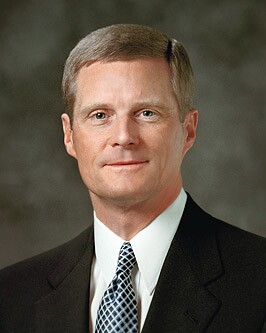This is truly an historic occasion. I believe there are those on the other side of the veil who are aware of and participating in what is taking place on this campus today. I have felt a tender spirit all day. I make no apology for my emotions, and I sense you are feeling exactly the same thing.
Today we recognize and reach back to the past, and we also look forward to and anticipate the future. One of the things that enables us to reach back and honor the past is to recognize descendants of Jacob Spori who are here in attendance with us today.
Jacob Spori and his wife Magdalena were the parents of six children. They had thirteen grandchildren and generations of other descendants. We are pleased to have three of their grandchildren with us today—two children of Elizabeth Spori Stowell, Jacob’s fifth child, and one from his youngest daughter, Annie Spori Kerr.
Sister Edna Stowell Taylor, would you please stand. Sister Taylor was born in 1913 in Annis, Idaho. She is the second daughter of Elizabeth Spori Stowell. Edna earned degrees from both Ricks College and Brigham Young University.
Brother Paul Stowell, would you please stand. Brother Stowell, the seventh child of Elizabeth Spori Stowell, was born in Rexburg in 1925. He graduated from both Ricks College and Yale Medical School.
Brother Robert Kerr, would you please stand. Brother Kerr is the eldest child of Annie Spori Kerr. He was born in 1914 in Ora, Idaho. He graduated with the last high school class at Ricks College and later attended the University of Idaho.
Brothers and sisters, I have been impressed by the parallels between what happened in the early years of the twentieth century at Ricks Academy and what now is happening in the early years of the twenty-first century at Brigham Young University-Idaho.
Construction of the original academy building was completed in the fall of 1903—in time for the start of a new school year and the beginning of classes. One hundred year later, this new structure is likewise finished and will house students and classes during the fall of 2003. On November 12, 1906, Elder John Henry Smith of the Quorum of the Twelve Apostles presided at the dedication of the original academy building. Today in 2003, President Thomas S. Monson, first counselor in the First Presidency of the Church, presides at this dedicatory service. In 1906 students, faculty, and church and civic leaders gathered to celebrate and anticipate the future of Ricks Academy. In 2003, we gather to reverence the legacy of Ricks College and to look forward to the future of BYU-Idaho.
In 1906, the edifice that later was to be named the Jacob Spori Building symbolized the beginning of Ricks Academy. In those early days there was a powerful spirit of pioneering, a spirit of willing sacrifice, and a spirit of experimenting and serving. Jacob Spori exemplified that spirit. How fitting that the first permanent structure on this campus eventually was named in honor of him.
Over the decades of its existence, the original Spori Building was the heart of this campus and the icon of the institution. I wonder if any of the people assembled at that first dedicatory service in 1906 could have imagined what would be here today.
In a similar fashion, the new Spori Building in 2003 represents the beginning of BYU-Idaho. There is on our campus today a renewed spirit of pioneering and sacrifice and experimenting and serving—truly a rethinking of education. And I wonder if any of us can possibly imagine what will be here 100 years from now. There will be an affection for this new Jacob Spori Building just as there was and is an affection for the original Jacob Spori Building. There will be stories, and there will be memories, and there will be sacred remembrances. How appropriate that elements of and fixtures from the first Spori Building have been so tastefully incorporated into this new building—a proper tribute to both the past and the future.
As we today participate in the dedication of the Jacob Spori Building, we simultaneously look to and reverence the past and look to and anticipate the future. We honor those who have gone before and done so much to make the present-day Brigham Young University-Idaho a reality. Brothers and sisters, there is a deep sense of history today as we walk on sacred, spiritual pathways which others have previously prepared and walked.
Those of us who now serve at BYU-Idaho acknowledge the hand of the Lord in the establishment, in the development, and in the progress and advancement of this remarkable institution. And we pledge our hearts and our hands and our minds and our spirits in service to the students who do now and will yet walk upon those same sacred pathways to obtain spiritual and secular truth. We will become the best we can become so we can most effectively teach and serve those students.
For all of us, this gathering today is more than a dedicatory service. It is a day of remembrance, a day of reverence, and a day of recommitment.
We are delighted that you could be here today and participate in this truly historic event. I pray that we will look to the past with fondness and gratitude and to the future with anticipation and hope.
The Master lives. The gospel has been restored to the earth in its fullness in these latter days. And this living Church is directed by a living Savior through living apostles and prophets. I so testify and witness in the sacred name of Jesus Christ, amen.
